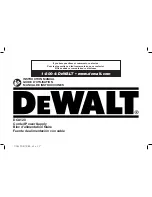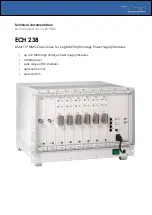
English
GENERAL OPERATIONAL PRECAUTIONS
1. Keep work area clean. Cluttered areas and benches
invite injuries.
2. Consider work area environment. Don’t expose
power tools t o rain. Don’t use power tools in damp
or wet locations. Keep work area well lit.
Don’t use tools in presece of flammable liquids or
gases.
Power tools produce sparks during operation.
They also spark when switching ON/OFF. Never
use power tools in dangerous sites containing
lacquer, paint, benzine, thinner, gasoline, gases,
adhesive agents, and other materials which are
combustible or explosive.
3. Guard against electric shock. Prevent body contact
with grounded surfaces. For example; pipes,
radiators, ranges, refrigerator enclosures.
4. Kep children away. Do not let visitors contact tool
or extension cord. All visitors should be kept away
from work area.
5. Store idle tools. When not in use, tools should be
stored in dry and high or locked-up place—out of
reach of children.
6. Don’t force tools. It will do the job better and safer
at the rate or which it was intended.
7. Use right tool. Don’t force small tool or attachment
to do the job of a heavy—duty tool. Don’t use tool
for purpose not intended—for example—don’t use
circular saw for cutting tree limbs or logs.
8. Dress properly. Do not wear loose clothing or
jewelry. They can be caught in moving parts. Rubber
gloves and non-skid footwear are recommended
when working outdoors. Wear protective hair
covering to contain long hair.
9. Use safety glasses. Also use face or dust mask if
cutting operation is dusty.
10. Don’t abuse cord. Never carry tool by cord or yank
it do disconnect from receptacle. Keep cord from
heat, oil and sharp edges.
11. Secure work. Use clamps or a vise to hold work.
It’s safer than using your hand and it frees both
hands to operate tool.
12. Don’t overreach. Keep proper footing and balance
at all times.
13. Maintain tools with care. Keep tools sharp and clean
for better and safer performance. Follow instructions
for lubricating and changing accessories. Inspect
tool cords periodically and if damaged, have repaired
by authorized service center. Inspect extension cords
periodically and replace if damaged. Keep handles
dry, clean, and free from oil and grease.
14. Disconnect tools. When not in use, before servicing,
and when changing accessories, such as blades,
bits, cutters.
15. Remove adjusting keys and wrenches. Form habit
of checking to see that keys and adjusting wrenches
are removed from tool before turning it on.
16. Avoid unintentional starting. Don’t carry plugged-
in tool with finger on switch. Be sure switch is off
when plugging in.
17. Outdoor use extension cords. When tool is used
outdoors, use only extension cords intended for use
for outdoors and so marked.
18. Stay alert. Watch what you are doing. Use common
sense. Do not operate tool when you are tired.
19. Check damaged parts. Before further use of the tool,
a guard or other part that is damaged should be
carefully checked to determine that it will operate
properly and perform its intended function. Check
for alignment of moving parts, binding of moving
parts, breakage of parts, mounting, and any other
conditions that may affect its operation. A guard
or other part that is damaged should be properly
repaired or replaced by an authorized service center
unless otherwise indicated elsewhere in this
instruction manual. Have defective switches replaced
by authorized service center. Do not use tool if
switch does not turn it on and off.
20. Do not use power tools for applications other than
those specified in the Handling Instructions.
21. To ensure the designed operational integrity of power
tools, do not remove installed covers or screws.
22. Do not touch movable parts or accessories unless
the power source has been disconnected.
23. Use your tool at lower input than specified on the
nameplate; otherwise, the finish may be spoiled
and working efficiency reduced due to motor
overload.
24. Do not wipe plastic parts with solvent. Solvents
such as gasoline, thinner, benzine, carbon
tetrachloride, alcohol, ammonia and oil containing
chloric annex may damage and crack plastic parts.
Do not wipe them with such solvent. Wipe plastic
parts with a soft cloth lightly dampened with soapy
water.
25. Consult an authorized Service Agent in the event
of power tool failure.
26. Use only genuine HITACHI replacement parts.
27. This tool should only be disassembled for
replacement of carbon brushes.
PRECAUTIONS ON USING AUTOMATIC
SCREWDRIVER
1. Use original bits specifically for the automatic
screwdriver.
Use no bits other than the original bits specifically
for the automatic screwdriver. Use of any other bit
can result in screws sticking out and screw feed
malfunctioning.
2. Screw in screws with the main unit held straight.
If the driver is slanted relative to the screw, the screw
head can be damaged and the bit worn. Moreover,
the prescribed torque is not transmitted to the screw,
resulting in screws left sticking out. Place the drive
straight against the screw and screw in.
3. Use the prescribed screws.
Do not use any other screws. They can cause
abnormal work (screws fallen over or sticking out)
and break downs (screw jamming and bit wear).
4. Protect your eyes with protective glasses.
Always wear protective glasses while working.
Drilling scatters plaster powder and tape dust, which
are dangerous if they get into your eyes.
5. Do not lubricate the driver.
Never lubricate the main unit of the driver. Doing
so can cause malfunctions and breakdowns.
21











































